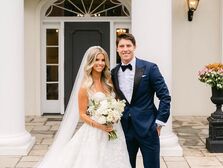How to Narrow Down Your Wedding Guest List Like a Pro
Of all the jobs you're tasked with in preparation for your very special day, creating the guest list is one of the most important. A guest list establishes the size of your wedding, which can then have an influence on all other aspects of your wedding day, including your venue, catering, floral and seating arrangements, favors and so forth. In short, it can help guide you in your process of determining the kind of wedding you really want to have.
That's why compiling a guest list, and later narrowing down a guest list, is typically one of the first tasks a couple should do when they start the planning process for their wedding. "Getting a tally of the number of guests will help the couple determine what venues can accommodate them and can also be provided to other vendors who might need this information before accepting to take them on as a client," explains Kelley Nudo, client coordinator at Momental Designs. "The guest list will also have an enormous impact on the budget, as smaller guest counts calculate to be less of an investment than larger guest lists, depending on selections, of course."
While the thought of putting together a list of all of your close family, friends and colleagues might sound like a really fun project, more often than not, it's a complicated and oftentimes overwhelming experience for couples planning their wedding—this is especially true when it comes to narrowing down the list. This is something you'll likely have to do should your venue or budget require you to reduce your head count.
Here, pros share their best tips for how to narrow down your wedding guest list.
In this article:
- Are You and Your Partner Included in the Guest Count?
- Best Way to Organize Your Wedding Guest List
- How to Cut Down Your Wedding Guest List
Are You and Your Partner Included in the Guest Count?
While it might sound silly because it's a total given that you and your partner will be in attendance on the most important day of your life, you should still include the two of you in your guest count. "In the early stages of your planning, it's less crucial to include yourselves as numbers are more general at this point, and two people likely won't make a difference, but as you get closer to your wedding, including yourselves is very important," explains Jamie Chang, owner and destination wedding planner at Mango Muse Events. "This will be necessary if you're close to capacity at the venue, but also for other vendors like catering, bar, rentals and other items that are based on your guest count."
Best Way to Organize Your Wedding Guest List
One of the more challenging aspects of working on your guest list is keeping it organized. Fortunately, The Knot's Guest List Manager has everything you need to streamline the whole guest list process. Here, experts share the tips they give their clients to help ensure their guest list is in working order.
Start with a rough brainstorming session.
Jen Sulak, Lead Wedding Photographer of Weirdo Weddings suggests starting with an immediate name brainstorm with your partner. "This should come fairly easy as you have probably built a life as a couple and have a close group of people you can start with," she says. It can be helpful to start this list in The Knot's Guest List Manager so that it can eventually become your official guest list.
Put people into groups.
One of the best ways to organize your guest list is by grouping people, notes Chang. "Knowing who is family and from which side, who are friends and what the different groups of friends are will help with multiple situations," she says. Start with immediate family, then move to close friends and relatives and continue on out from there. "If you need to trim your list, understanding where the bulk of guests are coming from can help with this, but this also helps once you get into seating charts so you can easily start putting people at tables," she adds.
Collect and add in your guests' information.
As you build your guest list out, you'll need some basic information that will come in handy as you move forward in the planning process, such as when you send out invitations. "Besides first and last names for each person, you'll want titles (if you're more formal), mailing addresses, email addresses and potentially cell numbers as well as for save the dates, invites, mass emails or mass texts," she says. "Having this information all in one place makes it easy as you're planning, but also for after the wedding and sending thank you cards."
If you choose to group people by household, be sure to write out the name of each family or household member who is invited to your wedding and mark the number of RSVPs you anticipate so you can properly keep track of how many will or will not come.
Jordan Xu, founder of Emily Jordan Events suggests making a special note for guests who are traveling from out of town so you can get an idea of how many room blocks you'll need. "As you input addresses into your guest list spreadsheet, make a note if they are out of town," she says. "You will then be able to easily sort the list by those guests who are out of town to figure out the number of rooms you will need available within your room blocks."
Add sections as you go.
As your planning moves along, Change also recommends adding additional sections to your guest list beyond basic information (again, super easy to do on The Knot!). "Having a section to track gifts received and thank you cards sent along with RSVPs, meal choices, dietary restrictions and special needs are all helpful pieces of information you'll need at some point during the planning," she says. "And having this all in one document with the basic information means you only need to look in one place for all the pertinent info."
Backup your work.
However or whenever you store your guest list, it's smart to have some sort of backup system in place. The Knot's Guest List Manager saves and backs up your list on your account, but you may want to create a separate, offline file that you can access in case of internet issues. And if you're into putting pen to paper, you might have a hard copy of your guest list as an extra, as well—though having a shareable online version on a platform like The Knot is your safest bet.
How to Cut Down Your Wedding Guest List
One of the hardest parts of the wedding-guest-list process is narrowing it down. Here, experts share their tips for how to narrow down your guest list if it's too big.
1. Consider your relationship with each person
Chang recommends asking yourself a few important questions before cutting someone from your guest list. "You want to ask yourself how close you are to that person, how well you know them, how well they know you and your partner and whether or not you're inviting them because you think you should or because you want to," she says. "Your final guest list should be a collection of people who you are truly close to, people who are important to you and you to them and relationships that will stand the test of time."
2. Give all contributing parties a guest count limit.
Those contributing to the guest list typically include yourself, your partner and both sets of parents. Most of the time, the couple provides 50 percent of the guest names collectively with each set of parents getting about 25 percent input each, explains Xu. "This can be a little difficult if one of you has a larger family, as that often upsets the percentage balance, but you can adjust accordingly to accommodate the family size," she says. "The percentage can also be split based on who is contributing to the wedding budget."
3. Eliminate plus-ones and/or children.
As much as you'd love for every single guest to bring a plus-one and for every parent to be able to bring their child(ren), that's not always feasible when you're trying to limit your guest list. "These are two types of guests that, many times, are nice to have but not must-have," explains Chang. "Now that's not always the case, but if that's the case for you, make some hard rules around both (e.g., only inviting plus ones that you have met, only invite kids of your immediate families) and then see how you can reduce from there."
























